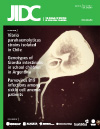Molecular and serological assessment of parvovirus B19 infections among sickle cell anemia patients
DOI:
https://doi.org/10.3855/jidc.1807Keywords:
parvovirus B19, sickle cell anemia, antibodies, RT-PCR, recomBlotAbstract
Introduction: Parvovirus B19 is a cause of hemolysis and red blood cell aplasia in patients with sickle cell anemia. The present study aimed to assess parvovirus B19 infection among sickle cell anemia patients.
Methodology: All patients (n = 138) included in the study were sickle cell anemia patients. Blood donors were used as a control group. Assessment of parvovirus B19 antibodies and viral DNA was performed using established methods of detection and B19 recomBlot assay.
Results: Detectable levels of parvovirus B19 IgG were found in 52 samples (37.6%) whereas anti-parvovirus B19 IgM antibodies were detected in four (2.89 %) patients of the sickle-cell anemia group. Anti-B19 IgM-positive samples contained B19-viral DNA. These four patients presented with fever, malaise, pallor and no cutaneous rash. Anti-parvovirus B19 antibodies were detected in 22 (39.3%) of the control blood donors group. Anti-parvovirus B19 IgM antibodies were not detected in the control group. Using the recomBlot assay, 58 test samples (42%) were found to contain detectable levels of Parvovirus B19 antibodies. All the samples that were positive for parvovirus B19 IgG by the ELISA were also positive by the recomBlot assay. Six samples were only positive by the recomBlot assay and not by the ELISA. Two of these six samples were positive for B19 viral DNA.
Conclusions: Establishing the extent of parvovirus B19 infection in sickle cell anemia patients will help in proper management of aplastic crisis in such patients. The B19 recomBlot assay may be suitable as a confirmatory assay.
Downloads
Published
How to Cite
Issue
Section
License
Authors who publish with this journal agree to the following terms:
- Authors retain copyright and grant the journal right of first publication with the work simultaneously licensed under a Creative Commons Attribution License that allows others to share the work with an acknowledgement of the work's authorship and initial publication in this journal.
- Authors are able to enter into separate, additional contractual arrangements for the non-exclusive distribution of the journal's published version of the work (e.g., post it to an institutional repository or publish it in a book), with an acknowledgement of its initial publication in this journal.
- Authors are permitted and encouraged to post their work online (e.g., in institutional repositories or on their website) prior to and during the submission process, as it can lead to productive exchanges, as well as earlier and greater citation of published work (See The Effect of Open Access).








